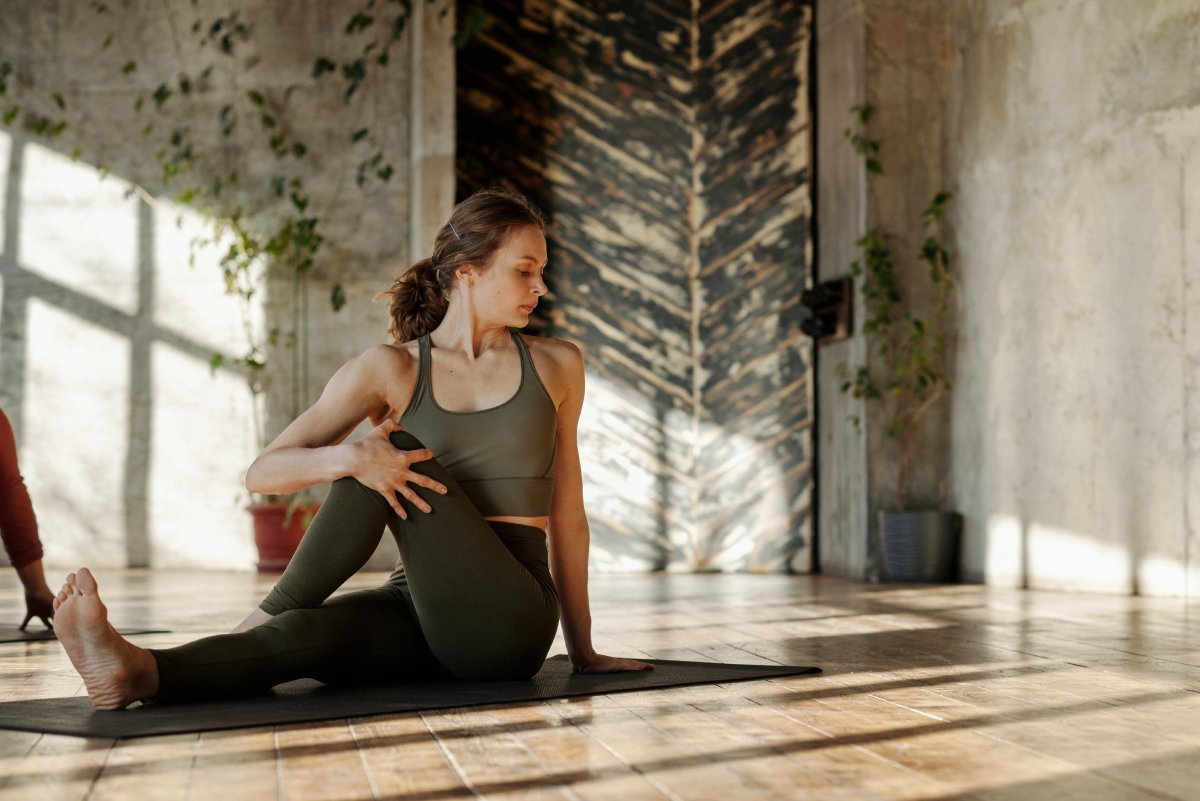When you’re waking up groggy, stiff, and a little past your alarm, the last thing you’re probably thinking of is a morning yoga routine.
A lot of us think of yoga practice as an afternoon pick-me-up or evening wind-down, but it can also be the perfect complement (or replacement) for your morning coffee.
An A.M. yoga flow offers gentle movement to awaken sleepy muscles and prepare you for the productive day ahead. Plus, you can do it in your pajamas!
We’ve all heard how the most successful and wealthy people seem to have some epic morning routine. But you don’t have to wake up at 4 AM or have mind-boggling flexibility to enjoy the benefits of morning yoga.
Even with a short morning flow, your body forms a habit of awakening, stretching, and mentally preparing for the day. This no-BS guide will help you reap all the benefits of morning yoga in just 15 minutes a day.
Benefits of Morning Yoga Routine
Everyone is busy these days, but micro-habits are the difference between being busy and being truly effective. Yoga is one of the best habits to build into your morning routine if you want to live a more productive yet peaceful life.
Instead of snoozing your alarm clock and instantly reaching for your phone, you can take a moment for yourself to stretch, relax, and feel calm before hammering out your to-do list.
Here are the science-backed physical and mental benefits of a morning yoga routine:
Major Stress Relief
Your body’s cortisol (stress hormone) levels are the highest within 30-45 minutes of waking up. Research shows that a yoga practice significantly reduces waking cortisol as well as blood pressure and heart rate.
Even if you’re stressed AF, research shows that just 10 minutes of deep breathing and light stretching can de-stress your body and even help increase your attention span throughout the day.
How you start your day is how you life your life, so why not start it with less stress and some quiet movement?
Better than Coffee?
If cortisol is highest in the morning, why the heck do we drink coffee? Caffeine stimulates the central nervous system and actually elevates cortisol even more. That’s bad news for anyone dealing with anxiety or chronic stress.
Yoga, on the other hand, energizes the body and mind while simultaneously reducing anxiety and getting our brains out of “fight or flight” mode.
We’re not saying you have to totally ditch your coffee (an after-yoga latte is actually a dream come true in my book), but you might consider getting your flow on before chugging down an espresso.
Improves Mental Health
Just getting out of bed can be extremely difficult when you’re dealing with depression, anxiety, or other mental health issues. Fortunately, yoga is now a scientifically-valid mind-body intervention for helping alleviate some of that mental strain.
Studies show that a yoga routine can help children and adults alike to improve their mindset, self-esteem, and cultivate a more positive outlook on life.
Helps You Focus
If you have trouble getting sh*t done in the morning, yoga can help with that too! Not only will morning yoga get your blood pumping, but it has also been proven to deepen concentration and focus throughout the day.
It turns out that bringing awareness to your breath isn’t just a woo-woo concept. It’s a science-backed hack to increasing productivity.
How to Create a 15 Minute Morning Yoga Routine
OK, we get it. Morning yoga is basically the panacea solution to all your problems.
But how do you actually incorporate a 15 min. yoga flow into your routine? And which yoga poses are the best morning stretches?
Start with easy warm-ups
First things first, don’t jump out of bed into an intense backbend like Wheel Pose or go for the full splits (that should be obvious, right?) The best morning routine starts with breathing and slow, easy movements.
Child’s Pose (Balasana)
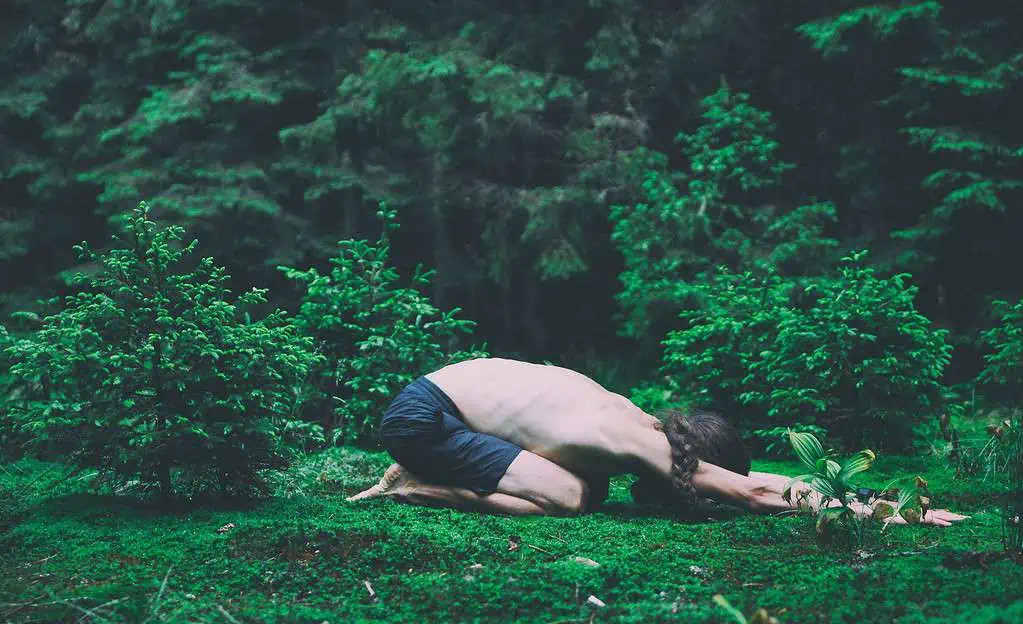
Benefits: Gently stretches hip and low back while awakening the legs
- Start on all fours in a table top position.
- Widen your knees a little wider than your hips and bring your heels together.
- Sit back with your tailbone onto your heels.
- Reach forward and lengthen your arms with the palms facing down.
- Sink your chest and forehead to the floor.
- Breathe for 4-5 breaths and settle deeper with each exhale.
- Optionally, walk your hands to one side of the mat and then the other for a side opening stretch.
Seated Side Bend (Parsva Sukhasana)
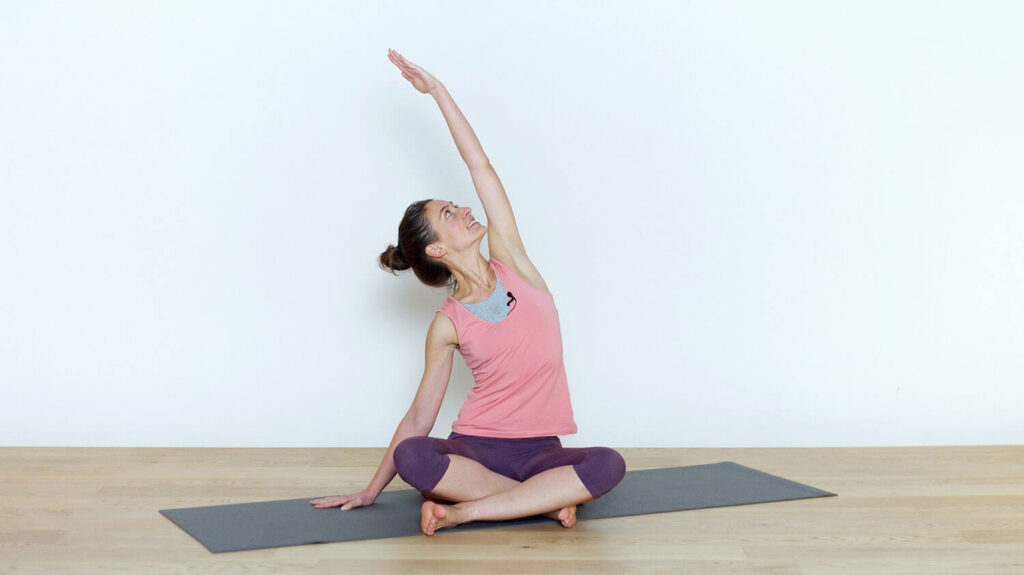
Benefits: Improve spinal flexibility and posture, awaken the obliques, stretch the neck, lats, and shoulders
- Come back to a comfortable cross-legged seated position.
- Inhale the spine up as straight as possible.
- Bring your arms straight up above your head, palms facing inward.
- Inhale deeply and reach up with the left arm as you bring the right hand to the floor.
- Keeping your back straight, arch in a C-shape over to your right side, feeling a long lengthening along the left side of your body.
- Hold for 2-3 breaths, then repeat on the other side.
Seated Forward Fold (Paschimottasana)
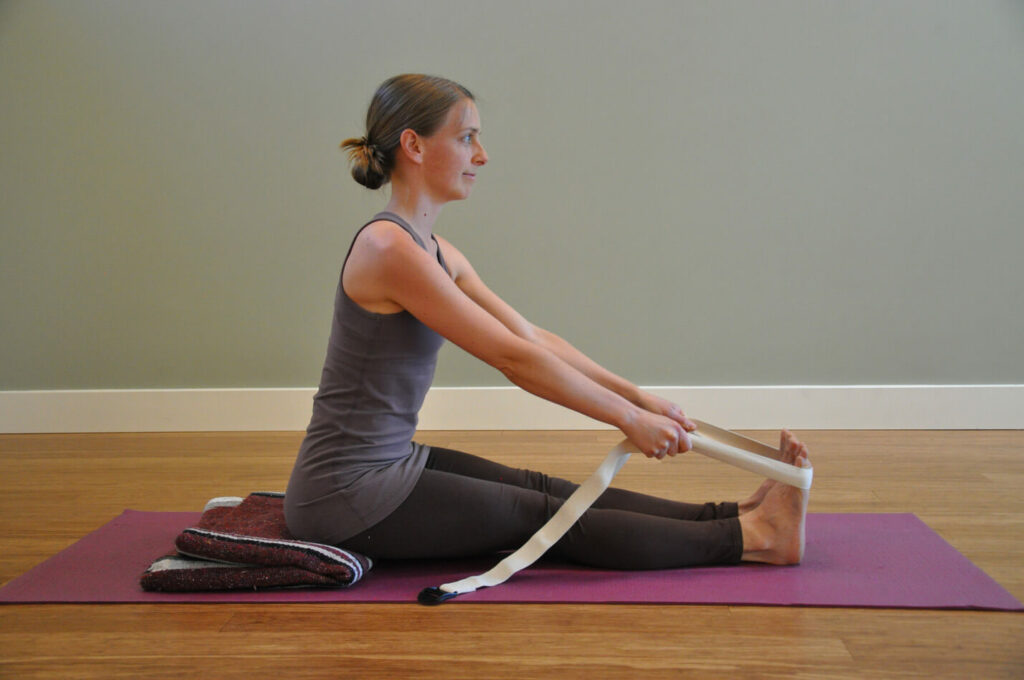
Benefits: Warm and stretch the hamstrings, relax nerves, relieve stiffness in the back and neck
- Start in a seated position with the legs out straight in front of you.
- Come up on your tailbone (optionally place a folded yoga blanket or bolster under your butt) and straighten the spine.
- Bend your knees enough to grip your calves or under your feet. If you can’t touch your toes, don’t worry, this is a light morning stretch after all.
- Maintain a straight spine and begin walking your feet away from you (or sliding your butt backwards) until you feel your hamstrings opening.
- Lift your torso and activate your core to keep the back straight as you breathe for 1-3 minutes.
- Optionally, use a yoga strap to add length. Don’t feel the need to force your body into a full-on tow-touching forward fold. Alignment and posture are key here.
Cat and Cow Poses (Marjaryasana)
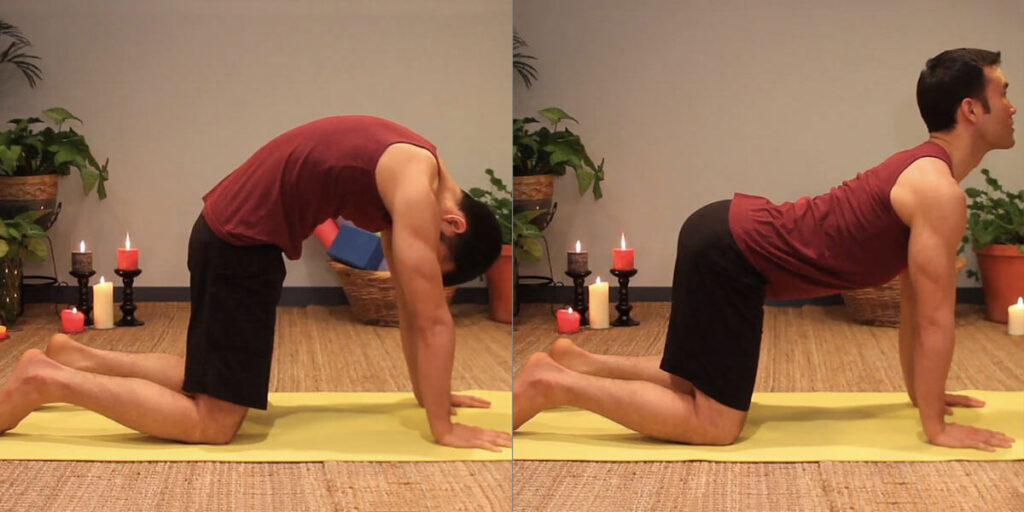
Benefits: Back and neck opening, spinal flexibility, warm up the core, and alleviate back pain
- Return to tabletop position with knees bent at hips width apart and hands stacked below wrists, elbows, and shoulders.
- On an inhale, move into cow pose by lowering the belly and simultaneously lifting the head and tailbone. Ensure there is no spinal compression, everything should feel lengthened and not forced.
- On the exhale, move into cat pose by tucking the tailbone and bringing your chin to your chest. Let your back round upward and hands push into the ground.
- Repeat as many rounds as feels good for you.
Move to light inversions and warming stretches
Next, move to standing and bring a little bit of muscle warming energy into your body with these asanas:
Mountain Pose (Tadasana)
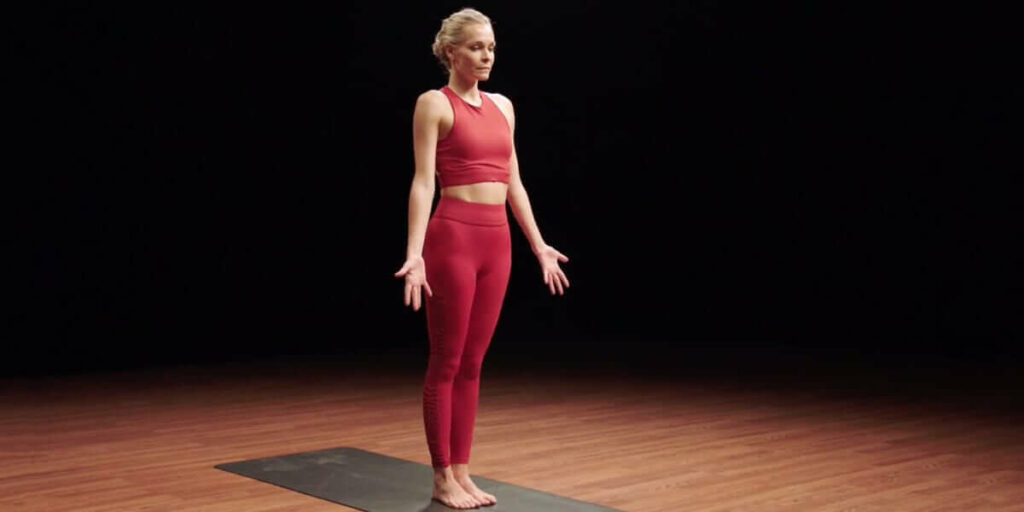
Benefits: Create stability, grounding, good posture, and awareness
- Coming to your feet, stand in the center of your mat or bedroom.
- Bring the feet touching together, toes facing forward, and thighs and quads engaged.
- Lengthen and straighten your spine as you subtly engage the core with each exhale.
- Bring your palms open to your side and rotate the shoulder blades down your back.
- Lift the head to a comfortable forward gaze and breathe for 5-10 breaths.
Chair Pose (Utkatasana)
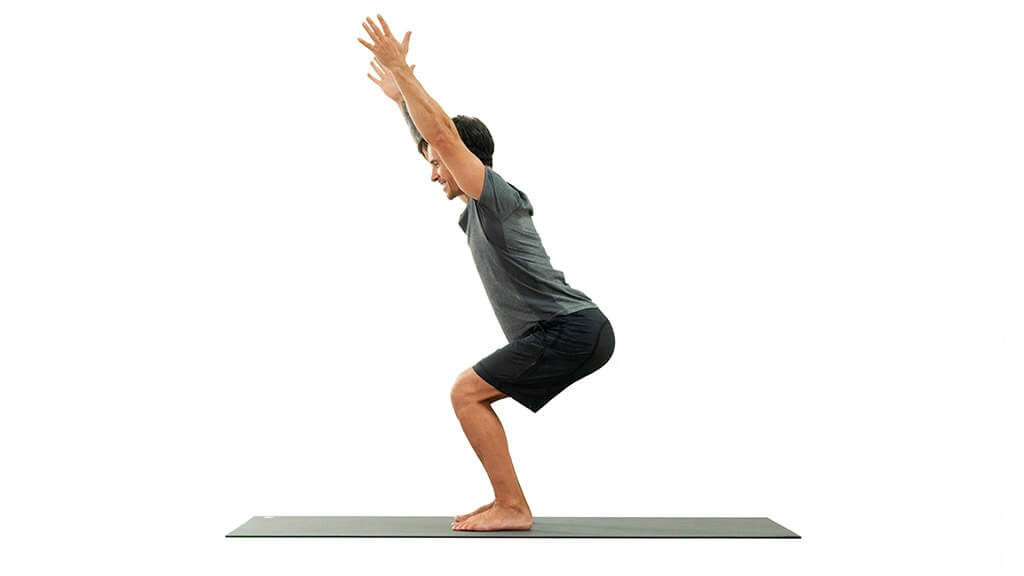
Benefits: Strengthen thighs, calves, and ankles while stimulating the heart and digestive organs, preventing joint pain, and bringing warmth into the body
- From Mountain Pose, bring your arms up by your ears with palms facing inward.
- On an inhale, engage your core and slowly begin to sit back as if a chair is behind you.
- The key to chair pose is to avoid over-arching the low back. Instead, keep the spine straightened as you feel the quads and thighs begin to activate.
- On each exhale, further engage the muscles and sit deeper into the pose. On each inhale, try to lengthen upward.
- Repeat for a few breaths, or until you feel warmed up.
Downward Dog (Adho Mukha Svanasana)
Benefits: Rejuvenate the back and mind while stretching open the shoulders, hamstrings, calves, and hands. Because it is slightly inverted, mountain pose is energizing and stress-relieving.
- From Mountain Pose with feet hip width apart, exhale your hands down and walk them forward until your body is in the shape of an upside down “V”.
- Keep your hands shoulder width apart and pressing into the ground.
- Let the head hang loosely between your shoulders.
- On an exhale, push your chest toward your thighs and let your heels begin to sink toward the floor.
- Optionally, alternate “walking” the downward dog by lifting one heel at a time to get a nice calf-warming stretch.
- Hold for 3-5 breaths.
End with hip openers
To round off your morning movement, toss in a few asanas to open up the hip flexors. In yogic philosophy, it is said that much of our emotional baggage and stress is accumulated in the hips.
Releasing hip flexor tension can be a little bit intense, so be sure to breath into these poses and don’t force anything.
Low Lunge (Anjaneyasana)
Benefits: Open the chest, groin, and thighs and reduce back pain for people with desk jobs
- From Downward Dog, step back with the right foot and place the top of your foot on the floor.
- Let your left knee bend and keep the left foot pushing onto the floor. The left thigh should be parallel to the floor and make a right angle with your calf.
- Inhale your upper body upward with the arms extended by your ears.
- On an exhale, slowly begin to open the chest toward the sky and feel a deep stretch in your groin and extended leg. Push your hip forward and down toward the floor.
- Take a few deep breaths and repeat on the other side.
Pigeon Pose (Eka Pada Rajakapotasana)
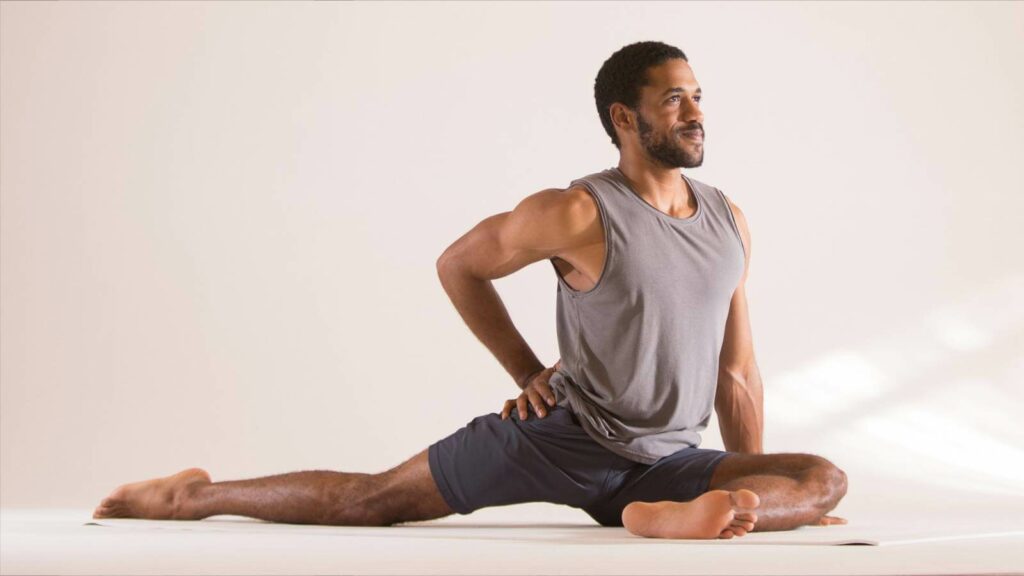
Benefits: Open the hips, improve overall mobility, improve posture, reduce low back pain and stiffness
- From Downward Dog, step one leg forward.
- Bend the front knee out and externally rotate your hip to open the knee to the side with the inside of your front foot facing upward. Make sure the knee is directly in line with the hip.
- Keep the back leg straight and adjust so that your hips are square to the front of your mat.
- On an inhale, lengthen the spine upwards.
- If you want more of a stretch, on an exhale, slowly begin walking the hands forward over the front leg.
- Sink into the hip flexors and breathe for a minute or two. Repeat on the other side.
Happy Baby Pose (Ananda Balasana)
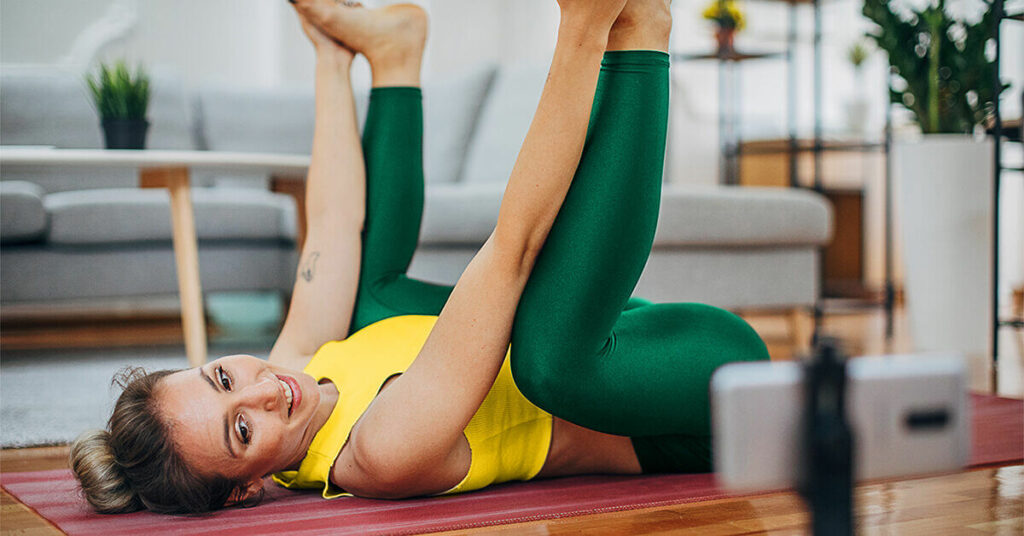
Benefits: Open the hips, massage the lower back, lengthen the spine, and calm the brain
- Begin laying down on your back with your head flat on the mat.
- Bend your knees toward the chest until they reach a 90 degree angle and the bottoms of your feet are facing the ceiling.
- Grab your big toes or the outsides of your feet and begin to spread your knees wider apart, slowly pushing them toward your armpits.
- You will feel a deep opening in your hips and groin, so be sure to go slow.
- Exhale and lengthen the tailbone toward the floor.
- Flex your feet flat and slowly begin to rock back and forth like a baby. Feel your quad muscles engage as you wake the hips and bend the knees deeper.
Bonus Energy-Booster: Lion’s Breath
If you want to really end your morning yoga with a bang, use this energy-boosting pranayama exercise to get ready to get off your mat (or bed) and take on the world. Lion’s Breath is also known to help improve confidence and help you start the day with a little laughter.
- Sit comfortably and bring your bent arms out to your side like “cactus” arms
- Open your eyes and look upward
- Take a deep inhale through the nose
- For the exhale, open your mouth and stick out your tongue
- Exhale the breath out with a force, making an “ahhh” sound as you keep your tongue out
- Repeat 3-5 times as needed, then return to normal breathing
FAQs
What is a good morning yoga routine?
The best AM yoga sequence is short, gentle, and easy to repeat on a daily basis. You should be able to do it with stiff muscles and groggy mind. Start with simple warmup poses like cat cow, downward dog, forward fold, and chair pose. Then, move into deeper hip-openers like low lunge, warrior poses, and happy baby. End with pranayama breathing to provide mental clarity and energy for your day.
How long should a morning yoga routine be?
A morning yoga session can be anywhere from 10 to 60 minutes, depending on how much time you have to prepare for the day ahead. Consistency is better than duration, so the ideal amount of time for you to practice yoga will be whatever you can keep up with on a daily basis.
Is 15 minutes of yoga a day enough?
Studies show that just 15 minutes of yoga is enough to reap numerous physical and mental benefits of this ancient practice, including stress relief, improved mental health, improved flexibility and mobility, as well as less back pain.


